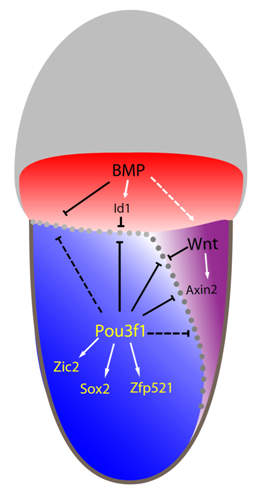
Scientists Discover Mechanism of Pou3f1 in Regulating Neural Fate Commitment of Pluripotent Stem Cells
Jun 27, 2014 Email"> PrintText Size

Stem cell based cell therapy has been largely applied in the clinical treatment for neurodevelopmental related diseases and neuronal degenerative disorders. The study on the mechanism, how pluripotent stem cells are directed to differentiate into specific cell lineages, is one of the hottest topics in life science and biomedical research. Appropriate neural initiation of the pluripotent stem cells is an imperative basis for the development of the central nervous system. However, how the neural fate commitment is ensured in the differentiation of the pluripotent stem cells remains unclear so far.
PhD students ZHU Qingqing, SONG Lu and their colleagues from the research group led by Prof. JING Naihe at Institute of Biochemistry and Cell Biology (SIBCB), Shanghai Institutes for Biological Sciences (SIBS), revealed that an intrinsic transcription factor Pou3f1 is essential for the neural differentiation of mouse embryonic stem cells during the transition from epiblast stem cells to neural progenitor cells.
Chimeric analysis confirms the neural fate-promoting activity of Pou3f1 in vivo. Genome-wide ChIP-seq and RNA-seq analyses indicated that Pou3f1 is not only an upstream activator of neural lineage genes such as Sox2, but also a repressor of BMP and Wnt signaling.
Their study establishes it for the first time that Pou3f1 functions as a critical dual-regulator of the intrinsic transcription factors and the extrinsic cellular signals to promote neural fate commitment. In addition, they reveal a novel mechanism of how the intrinsic and extrinsic regulatory networks are orchestrated to ensure the appropriate neural initiation of the pluripotent stem cells. Their discovery provides a better understanding of stem cell neural differentiation and stem cell therapy.
The study, entitled “The transcription factor Pou3f1 promotes neural fate commitment via activation of neural lineage genes and inhibition of external signaling pathways”, was published online in eLIFE on June 14, 2014.
This work was achieved in collaboration with Dr. LI Jinsong at SIBCB, and Dr. HAN Jingdong at the Key Laboratory of Computational Biology, CAS-MPG Partner Institute for Computational Biology, SIBS. The work was supported by grants from the Ministry of Science and Technology of China, the National Natural Science Foundation of China and Strategic Priority Research Program of Chinese Academy of Sciences.

Pou3f1 could activate the neural lineage genes and inhibit the external signaling pathways during the neural fate commitment in early mouse embryo. (Image by Prof. JING Naihe’s group)
Stem cell based cell therapy has been largely applied in the clinical treatment for neurodevelopmental related diseases and neuronal degenerative disorders. The study on the mechanism, how pluripotent stem cells are directed to differentiate into specific cell lineages, is one of the hottest topics in life science and biomedical research. Appropriate neural initiation of the pluripotent stem cells is an imperative basis for the development of the central nervous system. However, how the neural fate commitment is ensured in the differentiation of the pluripotent stem cells remains unclear so far.
PhD students ZHU Qingqing, SONG Lu and their colleagues from the research group led by Prof. JING Naihe at Institute of Biochemistry and Cell Biology (SIBCB), Shanghai Institutes for Biological Sciences (SIBS), revealed that an intrinsic transcription factor Pou3f1 is essential for the neural differentiation of mouse embryonic stem cells during the transition from epiblast stem cells to neural progenitor cells.
Chimeric analysis confirms the neural fate-promoting activity of Pou3f1 in vivo. Genome-wide ChIP-seq and RNA-seq analyses indicated that Pou3f1 is not only an upstream activator of neural lineage genes such as Sox2, but also a repressor of BMP and Wnt signaling.
Their study establishes it for the first time that Pou3f1 functions as a critical dual-regulator of the intrinsic transcription factors and the extrinsic cellular signals to promote neural fate commitment. In addition, they reveal a novel mechanism of how the intrinsic and extrinsic regulatory networks are orchestrated to ensure the appropriate neural initiation of the pluripotent stem cells. Their discovery provides a better understanding of stem cell neural differentiation and stem cell therapy.
The study, entitled “The transcription factor Pou3f1 promotes neural fate commitment via activation of neural lineage genes and inhibition of external signaling pathways”, was published online in eLIFE on June 14, 2014.
This work was achieved in collaboration with Dr. LI Jinsong at SIBCB, and Dr. HAN Jingdong at the Key Laboratory of Computational Biology, CAS-MPG Partner Institute for Computational Biology, SIBS. The work was supported by grants from the Ministry of Science and Technology of China, the National Natural Science Foundation of China and Strategic Priority Research Program of Chinese Academy of Sciences.

Pou3f1 could activate the neural lineage genes and inhibit the external signaling pathways during the neural fate commitment in early mouse embryo. (Image by Prof. JING Naihe’s group)
CAS Institutes
There are 124 Institutions directly under the CAS by the end of 2012, with 104 research institutes, five universities & supporting organizations, 12 management organizations that consist of the headquarters and branches, and three other units. Moreover, there are 25 legal entities affiliated and 22 CAS invested holding enterprisesThere are 124 I...>> more
Contact Us

Chinese Academy of Sciences
Add: 52 Sanlihe Rd., Xicheng District, Beijing, China
Postcode: 100864
Tel: 86-10-68597592 (day) 86-10-68597289 (night)
Fax: 86-10-68511095 (day) 86-10-68512458 (night)
E-mail: cas_en@cas.cn

